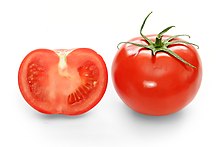
Back Атомат AB Trueng kléng ACE Tamatie AF ቲማቲም AM Tomato AMI Solanum lycopersicum AN Wulfpersoc ANG طماطم Arabic اوطه ARZ Solanum lycopersicum AST
| Tomato | |
|---|---|

| |
| Cross-section and full view of a hothouse (greenhouse-grown) tomato | |
| Scientific classification | |
| Kingdom: | |
| (unranked): | |
| (unranked): | |
| (unranked): | |
| Order: | |
| Family: | |
| Genus: | |
| Species: | S. lycopersicum
|
| Binomial name | |
| Solanum lycopersicum | |
| Synonyms | |
|
Lycopersicon lycopersicum (L.) H. Karst. | |
The tomato (Solanum lycopersicum) is a vegetable/botanical fruit, or specifically, a berry (but not a fruit as ordinary people use the word).[2]
Tomatoes are shiny and smooth with many small seeds. They are very good for health. Most tomatoes are red, but are green when unripe. They slowly change color from green to red as they get ripe, and as they gets ripe they get bigger and bigger. There are many different types of tomatoes. Some kinds of tomato are yellow or orange when they are ripe. Tomatoes are used a lot in Italian food. They are also used to make ketchup. Tomatoes are called fruit, because they contain seeds. Tomato seeds get spread around by being eaten by animals. After being eaten the seeds pass through the animal's digestive system. Although tomatoes are really fruits, many people call them vegetables and treat them like vegetables when they cook.
- ↑ "Phylogeny".
Molecular phylogenetic analyses have established that the formerly segregate genera Lycopersicon, Cyphomandra, Normania, and Triguera are nested within Solanum, and all species of these four genera have been transferred to Solanum
- ↑ "Tomato Description, Cultivation, & History".